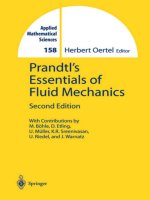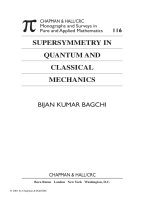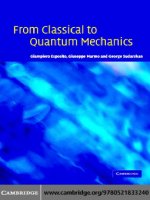- Trang chủ >>
- Khoa Học Tự Nhiên >>
- Vật lý
rajeev s.g. advanced classical mechanics.. chaos
Bạn đang xem bản rút gọn của tài liệu. Xem và tải ngay bản đầy đủ của tài liệu tại đây (457.36 KB, 100 trang )
PHY 411 Advanced Classical Mechanics
(Chaos)
U. of Rochester Spring 2002
S. G. Rajeev
March 4, 2002
Contents
ii
Preface to the Course
Introduction
Only simple, exceptional, mechanical systems admit an explicit solution in
terms of analytic functions. This course will be mainly about systems that
cannot be solved in this way so that approximation methods are necessary.
In recent times this field has acquired the name ‘Chaos theory’, which has
grown to include the study of all nonlinear systems. I will restrict myself
mostly to examples arising from classical physics. The first half of the course
will be accessible to undergraduates and experimentalists.
Pre-requisites
I will assume that all the students are familiar with Classical mechanics
at the level of PHY 235, our undergraduate course (i.e., at the level of the
book by Marion and Thornton.) Knowledge of differential equations and
analysis at the level of our math department sophomore level courses will
also be assumed.
Books
I recommend the books Mechanics, by Landau and Lifshitz and Mathe-
matical Methods of Classical Mechanics by V. I. Arnold as a general reference
although there is no required textbook for the course. The course will be
slightly more advanced than the first book but will not go as far as Arnold’s
book. The more adventurous students should study the papers by Siegel,
Kolmogorov, Arnold and Moser on invariant torii.
Homeworks,Exams and Grades
I will assign 2-3 homeworks every other week. Some will involve simple
numerical calculations. There will be no exams. The course will be graded
Pass-Fail.
Syllabus
•Newton’s equations of motion.
•The Lagrangian formalism; generalized co-ordinates.
iii
iv PHY411 S. G. Rajeev
•Hamiltonian formalism; canonical transformations; Poisson brackets.
•Two body problem of Celestial mechanics. Integrability of the equations
of motion.
•Perturbation theory; application to the three body problem.
•Restricted three body problem; Lagrange points.
•Normal co-ordinates; Birkhoff’s expansion; small denominators and reso-
nances.
•Invariant torii; Kolmogorov-Arnold-Moser theorems.
•Finding roots of functions by iteration: topological dynamics; onset of
chaos by bifurcation.
Special Topics for Advanced Students
•Ergodic systems. Sinai billiard table; geodesics of a Riemann surface.
•Quantum Chaos: Gutzwiller’s trace formula.
•Chaos in number theory: zeros of the Riemann zeta function.
•Spectrum of random matrices.
Chapter 1
Introduction
•Physics is the oldest and most fundamental of all the sciences; mechanics is
the oldest and most fundamental branch of physics. All of physics is modelled
after mechanics.
•The historical roots of mechanics are in astronomy-the discovery of reguar-
ity in the motion of the planets, the sun and the moon by ancient astrologers
in every civilization is the beginning of mechanics.
•The first regularity to be noticed is periodicity- but often there are several
such periodic motions superposed on each other. The motion of the Sun has
at least three such periods: with a period of one day, one year and 25,000
years (precession of the equinoxes). We know now that the first of these
is due to the rotation of the Earth relative to an inertial reference frame,
the second is due to the revolution of the Earth and the last is due to the
precession of the Earth’s axis of rotations.
•The first deep idea was to regard all motion as the superposition of such
periodic motion- a form of harmonic analysis for quasi-periodic functions.
This gave a quite good description of the motion.
•The precision at around 500 AD is already quite astonishing. The Aryab-
hatiyam gives the ratio of the length of the day to the year to an accuracy of
better than one part in ten million; adopts the heliocentric view when con-
venient; gives the length of each month to four decimal places; even suggests
that the unequal lengths of the months is due to the orbit of the Earth being
elliptical rather than circular. There were similar parallel developments in
China, the Arab world and elsewhere at that time.
•Astronomy upto and including the time of Kepler was mixed in with Astrol-
ogy and many mystic beliefs formed the motivation for ancient astronomers.
1
2 PHY411 S. G. Rajeev
•Kepler marks the transition from this early period to the modern era. The
explanation of his three laws by Newtonian mechanics is the first deep result
of the modern scientific method.
•Mechanics as we think of it today is mainly the creation of one man:
Isaac Newton. The laws of mechanics whch he formulated by analogy with
the axioms of Euclidean geometry form the basis of mechanics to this day,
although the beginning of the last century saw two basic changes to the
fundamental laws of physics.
•These are the theory of relativity and quantum mechanics. We still do not
have a theory that combines these into a single unified science. In any case
we will largely ignore these developments in these lectures.
Chapter 2
The Kepler Problem
•Much of mechanics was developed in order to understand the motion of
planets. Long before Copernicus, many astronomers knew that the appar-
ently erratic motion of the planets can be simply explained as circular motion
around the Sun. For example, the Aryabhateeyam written in 499 AD gives
many calculations based on this model. But various religious taboos and su-
perstitions prevented this simple picture from being universally accepted. It
is ironic that the same superstitions (e.g., astrology) were the prime cultural
motivation for studying planetary motion.
•Kepler used Tycho Brahe’s accurate measurements of planetary positions
to find a set of important refinements of the heliocentric model. The three
laws of planetary motion he discovered started the scientific revolution which
is still continuing.
1 The first law of Kepler is: Planets move along elliptical orbits with the Sun
at a focus.
2 An ellipse is a curve on the plane defined by the equation, in polar co-ordinates
(r, θ)
ρ
r
= 1 + cos θ.
2.1 The parameter must be between 0 and 1 and is called the
eccentricity. It measures the deviation of an ellipse from a circle: if = 0
the curve is a circle of radius ρ . In the opposite limit → 1 ( keeping ρ
3
4 PHY411 S. G. Rajeev
fixed) it approaches a parabola. The parameter ρ > 0 measures the size of
the ellipse.
•A more geometrical description of the ellipse is this: Choose a pair of points
on the plane F
1
, F
2
, the Focii. If we let a point move on the plane such
that the sum of its distances to F
1
and F
2
is a constant, it will trace out
an ellipse.
•Derive the equation for the ellipse above from this geometrical description.
( Choose the origin of the polar co-ordinate system to be F
2
). What is the
position of the other focus F
1
?
•The line connecting the two farthest points on an ellipse is called its major
axis; this axis passes through the focii. The perpendicular bisector to the
major axis is the minor axis. If these are equal in length, the ellipse is a
circle; in this case the focii coincide. The length of the major axis is called
2a usually. Similarly, the semi-minor-axis is called b .
•Show that the major axis is
2ρ
1−
2
and that the eccentricity is =
√
1 −
b
2
a
2
.
•The eccentricity of planetary orbits is quite small: a few percent. Comets
and some asteroids and planetary probes have very eccentric orbits.
•If the eccentricity is greater then one, the equation describes a curve that
is not closed, called a hyperbola.
•The second law of Kepler concerns the angular velocity of the planet:
3 The line connecting the planet to the Sun sweeps equal areas in equal times
.
3.1 Since the rate of change of this area is
1
2
r
2
dθ
dt
, this is the statement
that
1
2
r
2
dθ
dt
= constant.
•The third law of Kepler gives a relation between the size of the orbit and
its period.
4 The ratio of the cube of the semi-major axis to the square of the period is
the same for all planets.
PHY411 S. G. Rajeev 5
•Newton’s derivation of these laws from the laws of mechanics was the first
triumph of modern science.
5 In the approximation in which the orbits are circular, Kepler’s laws imply the
force on a planet varies inversely as the square of the distance from the Sun.
5.1 The eccentricities are small ( a few percent); so this is a good approxi-
mation. The first law then states that the orbits are circular with the Sun at
the center; the second that the angular velocity is a constant. This constant
is
˙
θ =
2π
T
, where T is the period. So the acceleration of the planet is
pointed towards the Sun and has magnitude r
˙
θ
2
= 4π
2
r
T
2
. The third law
says in this approximation that
r
3
T
2
= K , the same constant for all planets.
Thus the acceleration of a planet at distance r is
K
4π
2
1
r
2
. Thus the force on
a planet must be proportional to its mass and inversely proportional to the
square of its distance from the Sun.
•Extrapolating from this Newton arrived at the Universal Law of Gravity:
6 The gravitational force on a body due to another is pointed along the line
connecting the bodies; it has magnitude proportional to the product of masses
and inversely to the square of the distance.
6.1 If the positions are r
1
, r
2
and masses m
1
, m
2
, the forces are respec-
tively
F
1
=
[r
2
− r
1
]
Gm
1
m
2
|r
1
− r
2
|
, F
2
=
[r
1
− r
2
]
Gm
1
m
2
|r
2
− r
1
|
7 Newton’s second law gives the equations of motion of the two bodies:
m
1
d
2
r
1
dt
2
= F
1
, m
2
d
2
r
2
dt
2
= F
2
.
8 The key to solving the equations of motion is the set of conserved quantities.
6 PHY411 S. G. Rajeev
9 Since F
1
+ F
2
= 0 for any isolated system ( Newton’s third law) the total
momentum is always conserved:
m
1
dr
1
dt
+ m
2
dr
2
dt
= P,
dP
dt
= 0.
10 We can change variables from r
1
, r
2
to the center of mass and relative
co-ordinates: R =
m
1
r
1
+m
2
r
2
m
1
+m
2
, r = r
2
− r
1
to get
d
2
R
dt
2
= 0, m
d
2
r
dt
2
= −ˆr
Gm
1
m
2
|r|
2
where m =
m
1
m
2
m
1
+m
2
is the reduced mass.
10.1 The first equation is trivial; the second is the same as that of a single
body at position r moving in a central force field: we have reduced the two
body problem to the one body problem.
11 A central force field is pointed along the radial vector and has magnitude
depending only on the radial distance. Angular momentum L = mr ×
dr
dt
is
conserved in any central force field.
12 Hence the vector r always lies in the constant plane orthogonal to L .
13 In plane polar co-ordinates, the angular momentum is
L = mr
2
dθ
dt
.
14 We have jsut derived Kepler’s second law: since m is a constant, conser-
vation of angular momentum implies that the areal velocity
1
2
r
2
dθ
dt
is a constant.
15 A central force field is conservative: it is the gradient of a scalar function:
F = −∇U where U is a function only of the radial distance.
15.1 For the gravitational force, U(r) = −
Gm
1
m
2
r
2
.
PHY411 S. G. Rajeev 7
16 In any conservative force field, the total energy is conserved:
1
2
m
˙r
2
+ r
2
˙
θ
2
+ U(r) = E.
17 To determine the shape of the orbit we need r as a fucntion of θ . We can
eliminate t in favor of θ in teh above equation using conservation of angular
momentum:
dθ
dt
=
L
mr
2
⇒
dr
dt
=
dr
dθ
L
mr
2
= −
L
m
du
dθ
where u =
1
r
.
18 Thus we get
L
2
2m
[u
2
+ u
2
] = E − U(u), ⇒ θ −θ
0
=
u
u
0
2m
L
2
[E −U(w)] − w
2
−
1
2
dw
19 Exercise: Solve this ODE and obtain the equation for the ellipse for the case
of the Kepler problem.
20 The rate of change of area is a constant,
˙
A =
1
2
r
2
˙
θ =
L
2m
; the total area
of the ellipse is A = πab . These two facts combine to give us the period of the
motion, T =
A
˙
A
.
21 Exercise: Derive Kepler’s third law by simplifying the expression for the
period.
Chapter 3
The Action
•Newton formulated mechanics in terms of differential equations. Even at
that time there was a parallel view (eg., Leibnitz) that the laws of mechanics
could be formulated as a variational principle.
•For example the position of a body of in stable equilibrium is the minimum
of potential energy. More generally any extremum of the potential is an
equilibrium. Is there a similar principle which determines the path of a
particle in motion?
•Let Q be the space of all instantaneous positions of the system. For a
point particle it is the Euclidean space R
3
; for a system of n particles it
is R
3n
; for a pendulum of length L it is S
1
, the circle of radius L . This
space is called the configuration space.
•The path is described by a map from the real line (the set of values of
time) to the configuration space. This curve must be differentiable so that
we can speak of velocities: so the configuration space must be a differentiable
manifold and the curve must be differentiable.
•The dimension of the configuration space is the number of real numbers
we must specify to fix the position of the particle at any instant. It is also
called the number of degrees of freedom.
•Given the initial time, initial position and the final time and final position,
we expect a unique curve to connect them that satisfies the laws of motion.
This is reasonable if these laws are second order differential equations.
•Among all curves with prescribed endpoints, the curve that satisfies the
laws of motion are the extrema of a quantity called the action.
8
PHY411 S. G. Rajeev 9
•This action is the integral of a function of the position, velocity and time:
S[q] =
t
2
t
1
L(q, ˙q, t)dt
If we vary q slightly q → q + δq
δS =
δq
i
∂L
∂q
i
− δ ˙q
i
∂L
∂ ˙q
i
dt
•The variation must vanish at the endpoints: δq
i
(t
1
) = 0 = δq
i
(t
1
) . This
gives (after an integration by parts)
∂L
∂q
i
−
d
dt
∂L
∂ ˙q
i
= 0.
These differential equations are called the Euler-Lagrange equations.
• Example: Free particle. For a free particle in R
3
, all points are the same,
and all directions are the same and all instants of time are the same. These
imply that the Lagrangian is independent of the Cartesian co-ordinates q
i
, and of time t . It is a function only of
˙
q
2
. Galelean invaraince implies
in fact that it is proportional to tehe square of the velocity:
1
2
m
˙
q
2
. The
constant m is the mass.
•A basic principle of mechanics is that the motion of a system reduce to that
of a free particle for short enough time intervals. We can interpret this to
mean that the equations of motion are second order quasi-linear differential
equations (quasilinear means linear in the velocities: all the nonlinearities
are in the coordinates). The Lagrangian for a wide class of systems is of the
form
L(q, ˙q, t) =
1
2
g
ij
(q, t) ˙q
i
˙q
j
+ A
i
(q, t) ˙q
i
− V (q, t)
where g
ij
is a positive symmetric tensor.
•The simple example of a particle moving in R
3
in the presence of a
potential has
L(q, ˙q, t) =
1
2
m ˙q
i
˙q
i
− V (q, t)
Chapter 4
Symmetry and Conservation
Laws
•It is not possible to improve on the discussion in the book by Landau and
Lifshitz, so I just refer you to it.
10
Chapter 5
Systems with one degree of
Freedom
•Consider a system with one degree of freedom with Lagrangian
L =
1
2
m ˙x
2
− V (x).
Any conservative system with one degree of freedom can be brought to this
form by a choice of co-ordinates. For example the more general Lagrangian
L =
1
2
g(q) ˙q
2
− U(q).
can be brought to our form by the change of variables
x(q) =
q
q
0
√
g(q)dq, V (x) = U(q(x)).
•The equations of motion can be integrated once to get a first order ODE.
The simplest way to understand this is to not that the total energy is con-
served:
1
2
˙x
2
+ V (x) = E
Thus we can reduce the solution of the equation to quadrature:
t(x) −t
0
=
√
2
x
x
0
dx
√
[E −V (x)]
.
11
12 PHY411 S. G. Rajeev
Inverting this function gives position as a function of time.
• Exercise For the simple harmonic oscillator:
V (x) =
1
2
ωx
2
,
so that
t(x) −t
0
=
√
2
x
x
0
dx
√
[E −
1
2
ωx
2
]
.
Evaluate the integral by trigonometric substitutions.
•The simple pendulum is a ball of mass m hung from a fixed point by a
rigid rod of length l . The Lagrangian is
L =
1
2
ml
2
˙
θ
2
+ mgl cos θ.
Conservation of energy gives
1
2
ml
2
˙
θ
2
− mgl cos θ = E.
The energy thus has minimum value −mgl when the ball is at rest at θ = 0
. If E < mgl the ball will oscillate back and forth; when E > mgl the
ball will rotate around the point of support.
•The integral above will give the answer for time as a function of angle
in terms of an elliptic integral. There are many excellent books on elliptic
integrals eg. Higher Transcendental Functions ed. by Erdelyi. We will
look instead at the angle as a function of time which involve single functions
called elliptic functions.
•The Jacobi elliptic functions sn (u, k), cn (u, k), dn (u, k) are single
valued meromorphic functions of two complex variables u and k. They are
generalizations of the trigonometric functions. They can be defined by the
system of differential equations
d sn (u, k)
du
= cn (u, k) dn (u, k),
d cn (u, k)
du
= − sn (u, k) dn (u, k)
d dn (u, k)
du
= −k
2
sn (u, k) cn (u, k).
PHY411 S. G. Rajeev 13
with the boundary conditions
sn (0, k) = 0, cn (0, k) = 1, dn (0, k) = 1.
•It follows that (writing s for c for cn etc.)
s
2
+ c
2
= 1, k
2
s
2
+ d
2
= 1, d
2
− k
2
c
2
= 1 −k
2
for all (u, k) (they are like conservation laws for the ODE). (Prove this by
explicit differentiation!) The differential equation can thus be written as
s
2
= (1 −s
2
)(1 −k
2
s
2
).
•From the symmetry of the equation and boundary condition under reflec-
tion u → −u , we see also that sn (−u, k) = − sn (u, k), cn (−u, k) =
cn (u, k), dn (−u, k) = dn (u, k) .
•Clearly when k = 0 the solution is sn (u, 0) = sin u , cn (u, 0) = cos u
and dn (u, 0) = 1 . These are the limiting values of the Jacobi functions.
•The differential equation for the angle of the pendulum can be solved in
terms of sn by some change of variables. Once we notice the similarity
between the two equations, we put in the ansatz
u = ωt, sin
1
2
θ(t) = A sn (u, k).
With these definitions the ODE for the pendulum reduces to
2ml
2
ω
2
A
2
d sn (u, k)
du
2
= [E + mgl − 2mglA
2
sn
2
(u, k)][1 − A
2
sn
2
(u, k)]
•Comparing with the ODE for sn we get
E + mgl = 2mglA
2
= 2ml
2
A
2
ω
2
, A = k
as one way to reduce our ODE to Jacobi’s. (There are is another which
corresponds to a symmetry of sn (u, k) under k →
1
k
.)
•We get
ω =
g
l
1
2
, k
2
=
E + mgl
2mgl
.
14 PHY411 S. G. Rajeev
The solution is thus
sin
1
2
θ(t) = k sn (ω(t − t
0
), k).
•In the limit E → −mgl ,we get k → 0 , so that the solution reduces to
small oscillations around the point θ = 0
θ(t) ∼ 2k sin(ω(t − t
0
))
This is a familiar result . Indeed we recognize ω as the angular frequency
of this simple harmonic motion.
•When E < mgl we expect oscillatory motion around the equilibrium
point: there isnt enough energy to go all the way around. Thus physically
we expect sn (u, k) to be a periodic function. We can even get a formula
for the period from the earlier formula for time as a function of position: it
is just four times the time it takes to go from θ = 0 to the maximum value
of the angle, which is the root of E + mgl cos θ = 0 . The period can be
expressed in terms of the complete elliptic integral
K(k) =
π
2
0
dφ
√
[1 −k
2
sin
2
φ]
.
In fact,
sn (u + 4K(k), k) = sn (u, k).
•We can analytically continue the function to the complex plane in the u
variable. Surprsingly, sn is also periodic with an imaginary period: it is a
doubly periodic function of u . There is a simple physical way to understand
this. Replacing t → it in the equation of motion amonts to reversing the
sign of the potential and of energy. Thus in imaginary time we get the same
problem! Changing E → −E is the same as k →
√
[1 − k
2
] . So we have
a formula for the other period:
sn (u + 4iK
(k), k) = sn (u, k)
with
K
(k) = K(
√
[1 −k
2
]).
PHY411 S. G. Rajeev 15
(Here the prime does not stand for the derivative.)
•Since sn (0, k) = 0 we see that it has an infinite number if zeros, at the
points of a lattice in the complex plane. A doubly periodic analytic function
must have some singularities: otherwise it would be constant by Lioville’s
theorem. sn (u, k) has simple poles on a lattice as well.
• Exercise Show that sn (u, 1) = tanh u . What kind of motion of the
pendulum does this correspond to?. Show that as E → ∞ the motion
reduces to uniform circular motion with a large frequency.
• Exercise Use the differential equation to relate sn (u,
1
k
) to sn (u, k) .
Show then that as E → ∞ the solution tends to uniform circular motion.
•There is much more to the story; but you have to study the rest of this
fascinating story from other books. I recommend the book Elliptic Functions
by K. Chandrashekaran.
Chapter 6
Nonlinear Oscillations in One
Dimension
22 An oscillation whose amplitude is not infinitesimal is described by a nonlinear
equation.
23 The simplest case is a one dimensional system with a potential that has a
unique extremum, which is a minimum (one stable equilibrium).
23.1 For example, V (x) =
1
2
kx
2
+ λx
4
with k, λ > 0 has a unique
minimum at the origin.
23.2 Qualitatively such oscillations are similar to the harmonic oscillator:
all orbits are periodic. The main difference is that the period might depend
on the energy ( which is a measure of how much the oscillation departs from
the equilibrium.)
23.3 The Lagrangian
L =
1
2
m ˙x
2
− V (x)
leads to the equation of motion
m¨x = −V
(x).
16
PHY411 S. G. Rajeev 17
23.4 It is often convenient to regard the equations as a pair of first order
equations for position and momentum
dx
dt
=
p
m
,
dp
dt
= −V
(x).
23.5 Given the value of the position and momentum at any time, these
equations determine them for all future times. There are many reliable nu-
merical methods (for example, the Runge–Kutta method, built into Mathe-
matica) that compute this solution with sufficient accuracy.
23.6 Thus, it is convenient to regard the solution as a curve in the plane
(x, p) ; if we give initial conditions ( where the system is at any given time as
a point in this plane) the equations determine where it will be for all future
times.
24 The motion of a conservative system is described as a curve in the phase
space; each point in phase space is a set of values of position and momentum.
24.1 In our case of oscillations in one position variable, the phase space is
two dimensional.
25 In the case of a system of one degree of freedom, the conservation of energy
determines the shape of these curves.
25.1 The energy expressed as a function of position and momenta is called
the hamitonian:
H(x, p) =
p
2
2m
+ V (x);
We can imagine the hamiltonian as a function on the plane (x, p) , plotted
as a sort of ‘hill’. The bottom of the valleys of this plot describe stable
equilibrium points. The system evolves along contour plots,i.e., curves along
which the energy is a constant.
25.2 If V (x) has a single stable equilibrium point, these curve are ellipses
for small values of energy; as energy grows they will still be closed curves,
but no longer ellipses.
18 PHY411 S. G. Rajeev
-1.5 -1 -0.5 0.5 1 1.5
0.5
1
1.5
2
2.5
3
PHY411 S. G. Rajeev 19
-1 -0.5 0 0.5 1
-1
-0.5
0
0.5
1
20 PHY411 S. G. Rajeev
25.3 The period of the orbit is
T (E) = 2
√
2
m
x
2
(E)
x
1
(E)
dx
√
[E −V (x)]
where x
1
(E), x
2
(E) are solutions of the equations V (x) = E . (They are
called turning points). In this case there will be exactly two solutions, as
long as the energy is greater than the minimum value. The system oscillates
between these two points.
25.4 As we approach the minimum value of energy the turning points ap-
proach merge with each other and we get a static solution.
26 The area enclosed by the curve of constant energy W (E) , has many
interesting properties; for example the period of the orbit is T (E) =
dW (E)
dE
.
26.1 Prove this!.
26.2 Thus the area of an orbit is a monotonically increasing function of the
energy.
27 In the semiclassical approximation of quantum mechanics, the energy levels
are given by the Bohr-Sommerfeld condition:
W (E) = n¯h, n = 0, 1, 2, ···
27.1 The number of energy levels of energy less than E is the area enclosed
by the curve H(x, p) = E in units of Plank’s constant.
28 Thus the density of energy levels at energy E is equal to the classical
period divided by Plank’s constant:
T (E)
¯h
.
PHY411 S. G. Rajeev 21
-1.5 -1 -0.5 0.5 1 1.5
0.5
1
1.5
2
2.5
3









